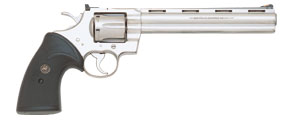|
Pachmayr Handgun Grips By David Tong  Traditional handgun grips have usually been made of hard plastic or wood. The most popular type of wood is walnut, but other woods, such as Cocobolo, Macassar Ebony, Goncalo Alves and Rosewood are also used. More recently, laminated hardwood has become reasonably popular. These wooden stocks are often checkered, which is cutting small diamonds into the wood. Checkering is mostly decorative, but may provide a better gripping surface for hands that are very sweaty, oily or greasy. In the 1960s, the late Frank Pachmayr purchased a company that made rubber grips built over a steel core shaped like the butt of a specific revolver or auto pistol. These had soft checkering molded into the rubber. I believe that the company was named Mershon before Pachmayr changed the name to his own. Mershon's rubber grips were originally offered as square-butt replacements for Colt and S&W double action revolvers, but the Company's offerings quickly spread to grips panels for popular auto pistols, including the Colt 1911, Browning Hi-Power and Walther PP. Pachmayr had always been a good marketer and he recognized the advantages of these synthetic rubber grips. They were nearly impervious to wear, did not crack or split and softened the blow of recoil to the hand. Moreover, because of rubber's tacky feel, these grips provided increased friction in the hand, especially if sweaty. Grips for revolvers were made for round, as well as square, butts and for the different sized frames. D-frame and I-frame for Colt, as well as a Peacemaker grip. S&W grips were available for J, K, and N frames. Ruger grips included the Speed and Security Six, as well as the Blackhawk and Single Six. The grips were clearly marked on the boxes end stickers and the suffixes used described the product, even though the artwork on the small white and red boxes was always the same. These suffixes included: -P: for Professional, the square-butt two and one-piece original designs. Later, a Decelerator grip was added. These use a softer elastomer insert near the web of the hand to help cushion the recoil of hard kicking revolvers and T/C single shot pistols. Auto pistol grips did not have quite as many variations. They were usually known as the Signature line of grips. 1911 grips originally had thumb shelves on both sides and also featured a small rounded tab that covered the top of the slight protrusion of the 1911's magazine floor plate. Later, Pachmayr removed the tab and both thumb rests and called the resulting grip style Combat, as it was more in keeping with a GI style handle and also provided unimpeded access to the magazine button. In addition, they also offered a grip with a molded, semi-circular recess behind the magazine button to provide even better access. The main features of Pachmayr grips were a steel liner that offered firm support for the molded rubber and covering both the front and rear grip straps on many revolvers and auto pistols. The latter added additional circumference to the grip of the handgun, but provided some welcome padding and increased control for powerful, hard kicking handguns. The gun squirmed less in the hand, making for faster and easier shot-to-shot recovery. An additional benefit that is not often discussed is the steel liner can provide increased protection to the shooter's hands in the event of a ruptured case head in some autoloading pistols, particularly 1911s. Gases venting downward into the magazine well will crack a standard wood grip, but with the steel and rubber envelope it is likely your hands will not suffer injury. The downside is that the steel lined rubber grips weigh more than the smallish wood or plastic grip panels they replaced. For example, standard 1911 grip panels might weigh a bit over an ounce, while Pachmayr's might weigh two or three ounces. Another potential issue for some is that the tackiness of the rubber tends to make correctly grasping the handgun's butt a bit slower. It can also compromise concealment under light cover garments, because clothing tends to stick to the grips. I have used Pachmayr grips on 1911s, Hi-Powers, a Colt Python and a slew of S&W revolvers. Pachmayr grips are still available, even though Mr. Pachmayr's gun shop on 1220 S. Grand Blvd. in downtown L.A. has long ceased to exist. The Lyman Company purchased the manufacturing and marketing rights to Pachmayr in 1996. I believe their operations are located primarily in Monrovia, CA, not far from where Pachmayr used to have a shotgun shooting school. Pachmayr grips are a relatively inexpensive way to aid control and grip security. Today, Pachmayr is probably better known for its rifle and shotgun recoil pads, which are more often installed on new factory and custom built rifles than any other brand. |